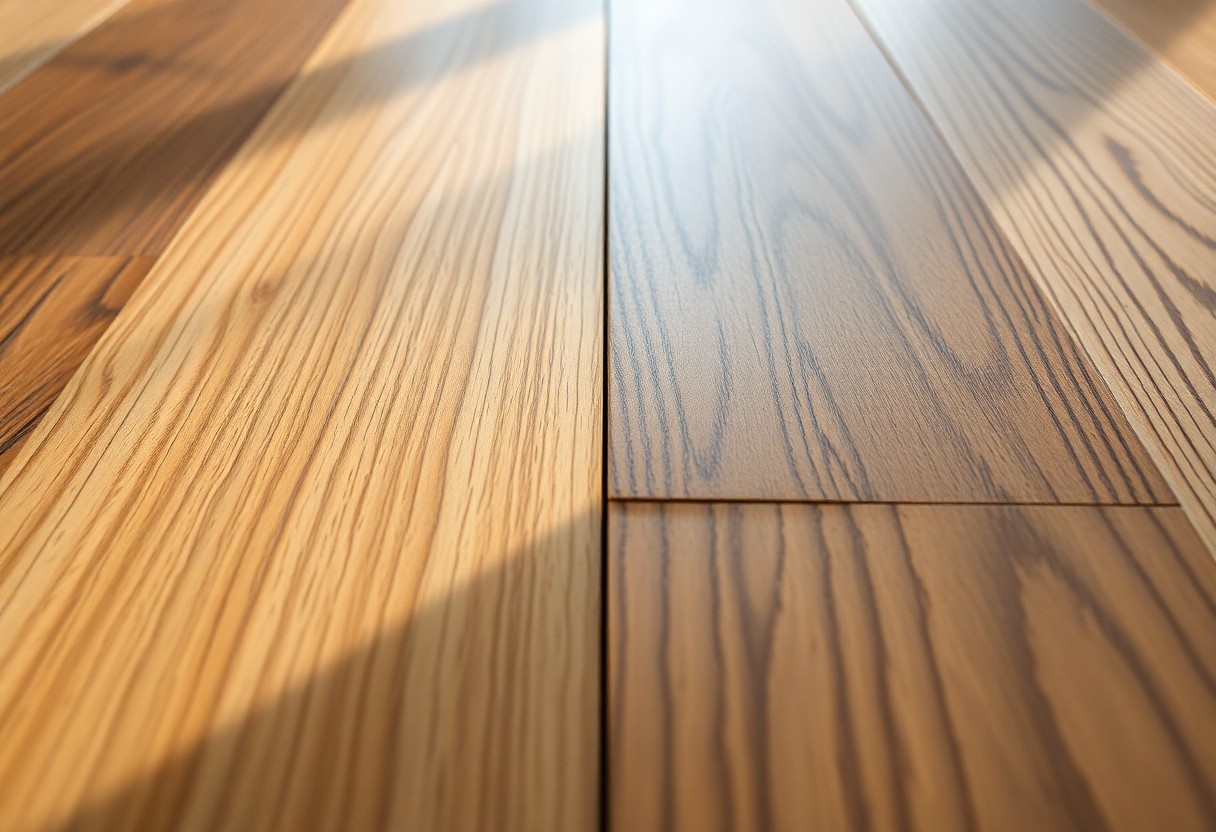Just when you think it’s time to choose new flooring, you might find yourself torn between the timeless appeal of hardwood and the modern versatility of vinyl. Both options bring their unique advantages and drawbacks, making the decision a bit overwhelming. In this blog post, you’ll explore the key differences, benefits, and suitability of each flooring type to help you determine which is best for your home. By the end, you’ll feel confident in making a choice that aligns with your style and lifestyle needs.
The Aesthetics Game: Visual and Design Differences
Choosing between vinyl and hardwood doesn’t only boil down to durability or cost; aesthetics play a significant role too. Hardwood flooring exudes a classic elegance with its natural patterns and grains, offering your space timeless beauty. In contrast, vinyl presents a myriad of design options that simulate wood, tile, or stone with impressive realism. While hardwood can enhance the warmth of a room, vinyl can cater to modern and eclectic styles, making it a versatile choice for contemporary homes.
Style Versatility: Tailoring to Your Home’s Theme
Vinyl stands out for its ability to adapt to different design themes, whether it’s rustic farmhouse or sleek modernism. Its vast array of patterns and textures allows you to match your flooring seamlessly with your decor, providing the flexibility to create varied atmospheres throughout your home. On the other hand, hardwood often lends itself to a more traditional aesthetic, which complements classic interior styles beautifully but may feel too formal for some modern designs.
Color Selection: Finding the Perfect Hue
As far as color selection, hardwood offers a limited palette influenced by the type of wood used, while vinyl boasts a multitude of colors and patterns. You can easily find shades that range from deep mahogany to light oak in hardwood, but the options for vinyl can include pastel colors, vibrant designs, and trendy textures that fit any artistic vision. This extensive color variety allows you to more easily express your personal style and find the perfect hue for your space.
This vast array of color options in vinyl is a game-changer. For instance, if you’re aiming for a beachy vibe, vinyl planks can mimic light sands or calming ocean hues, creating an airy atmosphere. Alternatively, if you’re looking for a rich, dramatic effect, dark vinyl options can evoke the sophistication of luxurious spaces. In addition, manufacturers regularly release new colors and designs, keeping vinyl flooring current with the latest trends, ensuring your home remains stylish for years to come.
Durability and Longevity: What You Need to Know
The choice between vinyl and hardwood extends beyond aesthetics to durability and longevity, crucial factors in your flooring decision. Hardwood can last for generations when properly maintained, sometimes surpassing 50 years. In contrast, vinyl flooring may have a lifespan of 10 to 25 years, depending on the quality and thickness of the material. Ultimately, your lifestyle, the level of foot traffic, and the specific environment of your home will significantly influence how long each flooring option stands the test of time.
Wear and Tear Resistance: How Each Holds Up Over Time
Vinyl flooring excels in wear and tear resistance due to its synthetic composition, which is designed to withstand heavy foot traffic and resist stains. On the other hand, while hardwood has a natural beauty, it can be vulnerable to scratches and dents, particularly in households with pets or young children. However, with proper care, hardwood can be refinished multiple times, restoring its original charm, making it a long-term investment.
Maintenance Requirements: A Comparison of Upkeep
Maintenance for your flooring can greatly differ between vinyl and hardwood. Vinyl requires minimal upkeep—regular sweeping and the occasional damp mop are sufficient. Conversely, hardwood demands more attention; not only do you need to regularly clean and polish it, but you’ll also face the prospect of refinishing every 5-10 years to keep it looking its best.
Maintenance Requirements Comparison
| Vinyl Flooring | Requires basic sweeping and occasional damp mopping; resistant to stains and moisture. |
| Hardwood Flooring | Needs regular cleaning, polishing, and refinishing every 5-10 years to maintain appearance. |
In terms of upkeep, vinyl’s resistance to moisture and stains minimizes maintenance efforts, making it ideal for busy families or those seeking convenience. Hardwood, while more demanding, offers the ability to enhance its beauty over time through refinishing and deep cleaning. Your choice should align with your lifestyle—selecting a low-maintenance option may benefit households with children or pets, while a commitment to active care may attract those who cherish the unique charm of hardwood.
Cost Analysis: Budgeting for Your Choice
Your budget plays a significant role in determining which flooring option aligns best with your financial plan. While both vinyl and hardwood flooring offer unique benefits, assessing your available funds will help you make the most informed decision. Consider not just the purchase cost, but also installation expenses, maintenance, and potential longevity when calculating your overall investment.
Initial Investment: Comparing Pricing Models
| Flooring Type | Average Cost per Square Foot |
|---|---|
| Vinyl Plank | $2 to $7 |
| Hardwood | $5 to $15 |
Long-Term Value: Analyzing ROI
Evaluating the long-term value of your flooring choice involves examining its return on investment (ROI). Hardwood may have a higher upfront cost, but it often lasts longer and can increase your home’s resale value. Conversely, while vinyl flooring is budget-friendly initially, it might require replacement sooner, resulting in a lower ROI over time.
Statistics show that hardwood floors can return up to 80% of your initial investment when selling your home, whereas vinyl’s resale value typically doesn’t exceed 50%. Additionally, hardwood flooring, with proper care, can last for generations, making it a better investment for long-term homeowners. This analysis highlights the importance of balancing your immediate budget against potential future gains when selecting your flooring.
Environmental Impact: Sustainability Factors
Both vinyl and hardwood flooring have environmental ramifications that are worth considering. While hardwood can be a more sustainable choice due to its natural source, it is vital to look for responsibly harvested wood. On the other hand, vinyl, often made from petroleum-based products, raises concerns about its long-term impact on the environment. Here are some points to contemplate:
- Hardwood requires sustainable sourcing and responsible forestry practices.
- Vinyl has a shorter life span, often leading to more waste.
- Hardwood can be refinished and repaired, while vinyl typically needs to be replaced.
- Recycling options may be limited for vinyl flooring materials.
After evaluating these aspects, you can weigh the environmental consequences of each flooring type as part of your decision-making process.
Sourcing Materials: Eco-Friendly Options
Finding sustainably sourced hardwood can significantly mitigate its environmental impact. Look for certifications like the Forest Stewardship Council (FSC) mark, which guarantees the wood comes from responsibly managed forests. Vinyl flooring, while often less eco-friendly, is now available in greener alternatives made from recycled materials and without harmful additives. Seeking out manufacturers committed to sustainable practices can mitigate the overall footprint of your flooring choice.
Life Cycle Assessment: Which Option is Greener?
A life cycle assessment (LCA) analyzes the environmental impacts of a product from raw material extraction all the way to disposal. Vinyl flooring, while affordable, has a significant carbon footprint due to its manufacturing process and materials. In contrast, hardwood, if sourced properly, presents a lower impact over its lifetime. Although hardwood has a longer life span, improper maintenance and the potential for deforestation can offset its advantages.
The life cycle assessment highlights that hardwood flooring, especially when sourced from sustainable forests, can result in a negligible carbon footprint over time. For instance, a 50-year-old hardwood floor generally has absorbed more carbon than it released during its production. Conversely, vinyl flooring not only adds to plastic waste but may also release harmful chemicals during its production and disposal phases. Making informed choices regarding both materials and manufacturers can lead to more sustainable home improvement outcomes while ensuring you keep your environmental credentials in check.

Noise and Comfort: The Underfoot Experience
Your comfort level at home often hinges on what you feel underfoot. Vinyl and hardwood perform differently in terms of acoustics and warmth, impacting your overall living experience. While hardwood provides a classic feel and can resonate sound beautifully, vinyl brings a softer touch that dampens noise effectively, creating a quieter environment. Whether you prioritize a cozy atmosphere or a sophisticated sound performance will guide your choice.
Sound Absorption: How Each Flooring Type Performs
In general, vinyl flooring excels in sound absorption compared to hardwood. Vinyl’s soft texture and structure can absorb impact noises better, making spaces quieter and more conducive to relaxation. In contrast, hardwood, being a harder material, may cause sound to travel more and echo within the room. If you have an active household or live in a multi-story home, this factor can influence your decision significantly.
Temperature Regulation: Keeping Your Home Cozy
As far as temperature regulation, hardwood generally retains warmth better than vinyl. Hardwood acts as a natural insulator, retaining heat during the winter months, which can help you maintain a cozy atmosphere. In contrast, vinyl can feel colder underfoot, especially in the cooler months, potentially affecting your indoor comfort level. Taking into account your local climate could influence whether you lean towards hardwood’s warmth or vinyl’s versatility.
| Vinyl | Often feels cooler underfoot, which may be uncomfortable in chilly seasons. |
| Hardwood | Retains heat better, providing a warmer feel during colder months. |
While both options have their benefits, hardwood’s ability to maintain warmth makes it a favorable choice in regions with colder climates. Many homeowners appreciate how hardwood floors can create a cozy, inviting environment, especially when paired with area rugs in strategic locations. In addition, hardwood’s thermal properties contribute to a consistent indoor temperature, enhancing overall comfort. Vinyl, though practical, may necessitate warming accessories like area rugs or heated flooring systems to achieve the same comfort level.
| Hardwood Benefits | Natural insulation properties offer warmth and comfort through seasonal changes. |
| Vinyl Concerns | Requires additional layers or systems for heat retention in colder areas. |
Final Words
Presently, choosing between vinyl and hardwood flooring for your home involves weighing factors like aesthetics, maintenance, and budget. Vinyl offers affordability and resilience, making it ideal for high-traffic areas, whereas hardwood adds timeless elegance and value, albeit at a higher cost. Ultimately, consider how each option aligns with your lifestyle and design preferences to make the best choice that suits your needs and enhances your living space.

